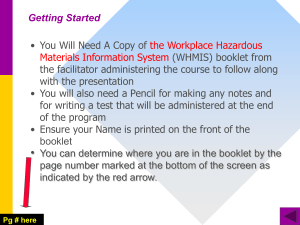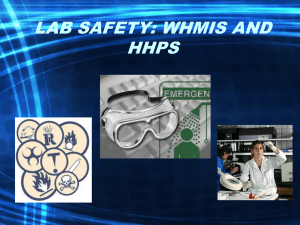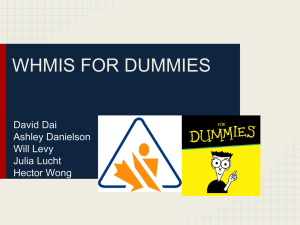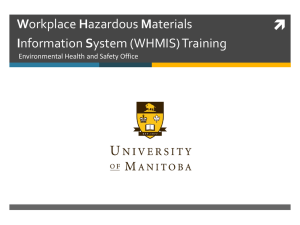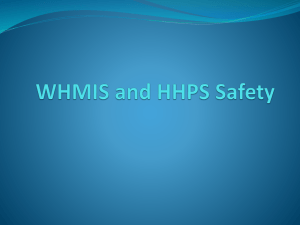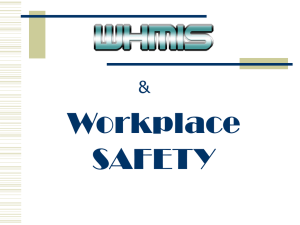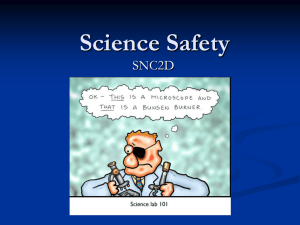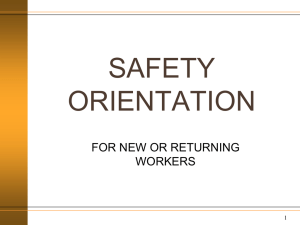whmis - WorkSafeNB
advertisement
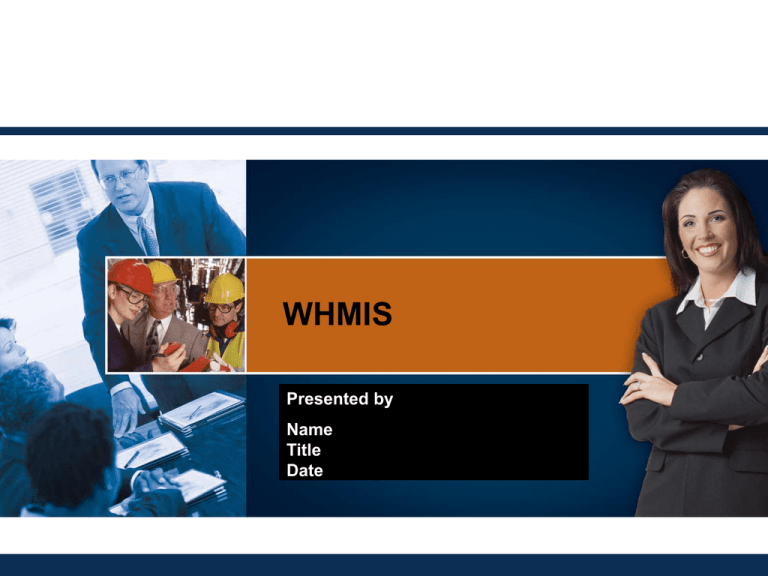
WHMIS Presented by Name Title Date WHMIS WHMIS W Workplace H Hazardous M Materials I Information S System Presentation Objectives At the end of this workshop participants will: 1. Understand the 3 basic elements of WHMIS. Recognize the 8 hazard symbols representing the 6 hazard classes 2. Be familiar with the 9 sections of the MSDS 3. Understand employer, supplier and employee responsibilities 4. Know how to find answers to any questions regarding the use of controlled products Course Outline Introduction WHMIS Labels Material Safety Data Sheets Worker Education WHMIS Legislation Summary Glossary - Common Terms in an MSDS English: www.ccohs.ca/oshanswers/chemicals/glossary/ French: www.cchst.ca/reponsessst/chemicals/glossary/ Introduction to WHMIS WHMIS is Canada-wide legislation, dealing with controlled products in the workplace. A controlled product is ‘any product, material or substance included in any one of the classes listed in the Hazardous Products Act (HPA).’ NOTE: HPA is federal legislation Hazardous Classes Under HPA Class A: Compressed Gas Class B: Flammable and Combustible Material Class C: Oxidizing Material Class D: Poisonous and Infectious Material Class E: Corrosive Material Class F: Dangerously Reactive Material WHMIS is Designed to Solve the Problem of: Unlabelled materials in the workplace Inadequate or contradictory information being given to employers/workers regarding identification, hazardous properties and precautions to be taken with hazardous materials used in the workplace Three Components of WHMIS 1. Labels on hazardous materials or their containers 2. MSDS or material safety data sheets which are technical bulletins providing more detailed information than the label 3. Worker education and training, providing instruction on hazards and safe work procedures Supplier Defined “Supplier" means a person who is a manufacturer, processor or packager of a controlled product or a person who, in the course of business, imports or sells controlled products; Hazardous Products Act (HPA) Flow of Information JHSC Producer input Supplier label Supplier Employer MSDS Importer Worker Training Informed worker Labels Two Types: 1. Supplier labels (developed and provided by the supplier) 2. Workplace labels (developed and used in the workplace) Supplier Label: Design and Application Content layout: not legislated Border: specific Colour: not legislated Legibility: distinct; good contrast Durability: able to withstand normal use Application: imprinted; stencilled; attached Language: English and French Supplier Label: Required Statements 1. Product Identifier 2. Hazard Symbols 3. Risk Phrases 4. Precautions 5. First Aid 6. Supplier Information 7. Reference to MSDS Supplier Label What is the Key to Everyday WHMIS in the Workplace? HAZARD SYMBOLS! HAZARD SYMBOLS What Does This Symbol Mean? What Do We Know? Compressed Gas (Class A): Poses an explosion danger because the gas is under pressure Container may explode if heated or dropped Container may become a projectile if the stem is broken off Examples Compressed Gas (Class A): Examples: Oxygen Acetylene Propane Spray paint Etc. Compressed Gas Accident What Does This Symbol Mean? What Do We Know? Combustible and Flammable Material (Class B): Will burn and is therefore a potential fire hazard May burn at relatively low temperatures; flammable materials catch fire at lower temperatures than combustible materials May burst into flame spontaneously in air, or release a flammable gas on contact with water May cause a fire when exposed to heat, sparks, or flames, or as a result of friction Examples Combustible and Flammable Material (Class B): Flammable: Butane, propane, hydrogen gas, acetone, gasoline, isopropyl alcohol, magnesium alloys, etc. Combustible: Kerosene, diesel, mineral spirits, varnish, etc. Flammable Vapours + Spark = Fire Flammable Gas Accident What Does This Symbol Mean? What Do We Know? Oxidizing Material (Class C): Poses a fire and/or explosion risk in the presence of flammable or combustible material May react violently when it comes into contact with combustible materials such as fuels or wood May burn skin and eyes upon contact Examples Oxidizing Material (Class C): Examples: Perchloric acid Hydrogen peroxide Nitric acid Compressed oxygen Ozone Oxidizing Accident What Does This Symbol Mean? What Do We Know? Poisonous and Infectious Material (Class D, Division 1): Is a potentially fatal poisonous substance May be fatal or cause permanent damage if it is inhaled or swallowed or if it enters the body through skin contact May burn eyes or skin upon contact Examples Poisonous and Infectious Material (Class D, Division 1): Examples: Sodium cyanide Hydrogen sulphide Carbon monoxide Sulphuric acid Toluene What Does This Symbol Mean? What Do We Know? Poisonous and Infectious Material: Other Toxic Effects (Class D, Division 2): Not immediately dangerous to health May cause death or permanent damage as a result of repeated exposure over time May be a sensitizer, which produces allergic reactions May cause cancers, birth defects, or sterility Examples Poisonous and Infectious Material: Other Toxic Effects (Class D, Division 2): Examples: Asbestos Lead Cadmium Benzene Mercury What Does This Symbol Mean? What Do We Know? Poisonous and Infectious Material: Biohazardous, infectious material (Class D, Division 3): May cause a serious disease resulting in illness (AIDS, Hepatitis) or death Can also include tetanus protection Examples Poisonous and Infectious Material: Biohazardous, infectious material (Class D, Division 3): Examples: Salmonella bacteria Hepatitis B virus HIV-AIDS Parasites Bodily fluids, such as blood and urine What Does This Symbol Mean? What do We Know? Corrosive Material (Class E): Causes severe eye and skin irritation upon contact Causes severe tissue damage with prolonged contact Often produces vapour or fumes that may be harmful if inhaled Examples Corrosive Material (Class E): Examples: Sodium hydroxide (caustic soda) Hydrochloric acid Nitric acid Sulphuric acid What Does This Symbol Mean? What Do We Know? Dangerously Reactive Material (Class F): Is very unstable May react with water to release a toxic or flammable gas May explode as a result of shock, friction or an increase in temperature May explode if heated when in a closed container Undergoes vigorous polymerization Examples Dangerously Reactive Material (Class F): Examples: Vinyl chloride Picric acid Some cyanides Dangerously Reactive Accidents Workplace Labels • • • • Methanol Product Identifier Avoid inhaling vapours, handle Information on safe with care handling of the Flammable product Avoid eye and skin contact See MSDS for more information Reference to MSDS Workplace Labels Must be displayed to give clear warning to employees May be a label, tag, sign or other Is not required to be bilingual; can be in the language of the workplace Quiz A: True or False? 1. Labelled products, MSDSs and worker education can help lower the risk of accidents. 2. WHMIS is a hazard class driven system. (name the classes) 3. A WHMIS supplier label can be identified by its solid red border. 4. A supplier label must list precautions and first aid instructions. 5. All workplace labels present in New Brunswick workplaces must be in both English and French. Material Safety Data Sheets The MSDS is: - A technical information reference for worker education, control measures and emergency response - A document that can be distributed - A document that must be available to workers Material Safety Data Sheets The MSDS is NOT: - All the information needed for the safe use of a product in every possible situation - A document only to be read and filed MSDS Required Criteria 1.Product Identifier 2. Ingredients 3.Physical Data 4.Fire and Explosion Hazards 5.Reactivity Data 6.Toxicological Properties 7.Preventive Measures 8.First Aid Measures 9.Preparation Information Section 1: Product Identification and Use The intent of this section is for product identification, supplier identification, and a description of the product use It is of particular use in organizing data sheets for quick retrieval It includes the emergency telephone number Section 2: Hazardous Ingredients This section provides information on the identity, concentration, and estimators of acute toxicity for the ingredients of a controlled product Copyright law permits limiting information in this section however, disclosure is mandatory if a worker is exposed to the product Useful information for emergency health care providers Lethal Dose and Lethal Concentration •The lower the lethal dose and lethal concentration numbers, the more dangerous the material is to human beings. LD50 / LC50 Section 3: Physical Data This section provides a physical description of the product It describes its response to changes in the physical environment, and has specific applications for ventilation system design and emergency procedures Section 4: Fire or Explosion Hazard The intent of Section 4 is to provide information to assist with fire and explosion prevention, as well as emergency procedures. This section is particularly important with flammables, solvents, organic peroxides, explosives, metal dusts and other unstable substances. If the product is not flammable or explosive, information in this section must reflect that fact. Section 5: Reactivity Data Information on the stability of the product and its likelihood of dangerous reaction with other chemicals Implications for handling procedures and storage arrangements May be useful along with Section 4 data for the prevention and control of fires or explosions Section 6: Toxicological Properties This section provides information on how a material is likely to enter the body and what short and long-term effects it is likely to have Includes signs and symptoms of exposure and pre-existing medical conditions which may be aggravated Information in this section is an important determinant of preventive and first aid measures and emergency care Section 7: Preventive Measures Provides clear direction for transportation, storage, use and disposal of the product, as well as emergency procedures related to accidental release Information must be as specific as possible. Employers may need to adapt information from data sheets to the specific hazard circumstances of each workplace Section 8: First Aid Measures Information necessary for the safe evacuation and immediate treatment of a person experiencing acute effects of overexposure Meant for use by workers on site, including first aid personnel Usually expands on the first aid instructions described on the supplier label Section 9: Preparation Information Name and telephone number of those responsible for MSDS preparation Date of preparation WHMIS legislation requires that MSDS be kept current; no older than 3 years General Approach to MSDS Identify the chemical and the emergency telephone number Know the hazards/precautions Understand safe handling and storage procedures Emergency procedures (in case of an emergency bring the MSDS with you to the hospital) Identify the preparation date Quiz B: True or False? 1. An MSDS contains the same information that is present on the supplier label. 2. An MSDS has all the information for every possible situation and workplace. 3. An MSDS can be used to determine safe storage requirements and emergency procedures. 4. An MSDS does not include the emergency telephone number of the manufacturer or supplier. 5. MSDSs must be stored together and indexed for easy access. WHMIS Legislation NEW BRUNSWICK REGULATION 88-221 under the OCCUPATIONAL HEALTH AND SAFETY ACT Worker Training and Education 6(3) An employer shall ensure, so far as is reasonably practicable, that the program of employee instruction and training required by subsection (1) results in an employee being able to apply the information as needed to protect the employee’s health and safety. Worker Training and Education Anyone working with or near controlled products must be trained in hazard information and procedures regarding: 1. 2. 3. 4. 5. Safe use Storage Handling Disposal Emergency procedures Worker Training and Education Includes information found on labels (supplier and workplace), MSDS and any information of which the employer is aware *The training should be: Relevant to the workplace Performance oriented Developed in consultation with the JHSC Reviewed at least annually Modified as conditions change Quiz C: True or False? 1. Employers must train workers who work with or near hazardous materials. 2. All employees should receive WHMIS training whether or not they are working with controlled substances. 3. Employees do not need to know emergency procedures regarding hazardous materials. 4. Employees need to be given information for controlled products flowing through pipes in the workplace. 5. An employee’s knowledge of the product can affect the amount of damage or injury in an emergency. Exceptions to the rule… Eight classifications exempt from WHMIS labelling and MSDS requirements. Some categories are regulated for worker education, some are not. 1. Explosives 2. Cosmetics, drugs,food 3. Pesticides 4. Radioactive materials 5. Consumer products 6. Wood products 7. Tobacco products 8. Manufactured articles Exceptions to the rule… •Exceptions are usually covered under other Legislation (example, Pesticides Control Act). •Products brought into the workplace that are not designed for commercial or industrial use (consumer products) are still controlled products under the HPA (MSDS and workplace labels may be required). WHMIS Responsibilities Suppliers, employers and employees each have a role to play in making WHMIS work! Supplier Responsibilities Supplier responsibilities are found under the Hazardous Products Act (Federal Bill C-07) and the Occupational Health & Safety Act, Section 13 Suppliers Must: I. Label controlled products intended for workplace use II. Supply MSDS with each controlled product Employer Responsibilities The employer’s WHMIS responsibilities are outlined in Provincial Regulation 88-221: To obtain MSDS from supplier Ensure appropriate labelling (supplier and workplace) Provide adequate instruction and training to employees Sort and file the MSDS in a clearly indicated and easily accessible area Employee Responsibilities WHMIS legislation does not place any direct responsibility on the workers, however under Section 12 of the OHS Act, employees must: Comply with the Act Conduct themselves to ensure their health and safety Report hazards Wear/use protective equipment Consult/co-operate with the JHSC Quiz D: True or False? 1. The workplace copy of the MSDS needs to be updated every three years, even if there has been no change in the hazard information. 2. The employer shall review their WHMIS system (employee training and MSDS) at least once a year. 3. Pesticides are exempt from MSDS and label requirements, therefore worker training isn’t necessary. 4. Telling workers to read the labels and the MSDS is adequate training. 5. Employees don’t have to watch out for their own safety; it’s the boss’s responsibility. Developing WHMIS for your workplace Step 1: Assign responsibility Inventory and list supplier and workplace labels Step 2: Get current MSDS Determine storage, handling, training, first aid and disposal Step 3: Train employees Implement control measures and MSDS binders Summary WHMIS has ‘three components’: WHMIS is a ‘hazard class’ driven system 1. Labels 2. MSDS 3. Worker Education Compressed Gas Flammable Oxidizers Poisons Corrosives Reactive Summary Employers must train their workers to use the information provided by Training should be reviewed and/or updated Labels MSDS Yearly, or as conditions change

